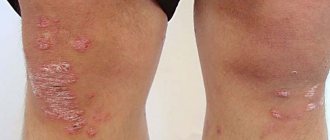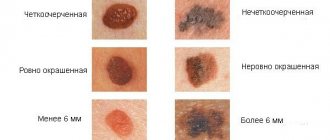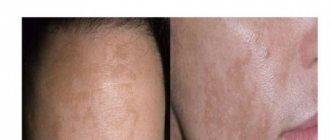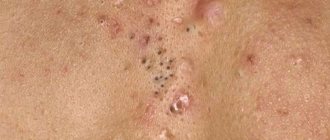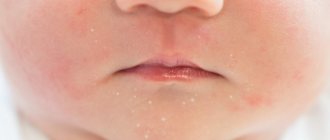Blackheads on legs can appear for many reasons. Some of them can be as harmless as freckles and comedones, while others, such as diabetic dermopathy, lentigo, warts and moles, are a symptom of a serious disease. This problem is also often encountered by women after unsuccessful hair removal. This cosmetic defect is especially worrying ahead of the upcoming summer season. If you have dark spots on your legs or other parts of your body, it is best to consult your family doctor or dermatologist.
Causes
The main reasons for the appearance of blackheads are associated with the following factors:
- Excessive exposure to the sun, after which solar lentigo, or liver spots, appear on the skin. They are associated with age-related changes and are typical for people over 55 years of age. They can occur on any part of the body.
- Freckles can also be caused by sunlight or simply be inherited. Doctors do not consider them a disease.
- Diabetic dermopathy in the form of brown or red spots on the lower extremities. Caused by changes in small vessels in diabetic patients.
- Moles that appear on the skin in the first 20 years of life are considered benign and do not cause concern. However, you should be wary of those that suddenly began to change their shape, color, boundaries, began to hurt and itch.
- Melanoma is a type of malignant mole that hurts and bleeds. The most likely causes of their occurrence are considered to be excess ultraviolet radiation and a genetic factor.
- Comedones are a clogged sebaceous duct with a black dot on the surface of the skin, which is formed as a result of poor hygiene and hormonal changes.
- Ingrown hairs after any type of hair removal are formed as a result of violation of the technology of the procedure itself and improper skin care before and after it.
Oily and problematic skin, which is more common at a young age, is more prone to the appearance of blackheads - comedones. Hormonal storms in the body, characteristic of this period, cause excessive secretion of the sebaceous glands and a change in the consistency of sebum. It becomes thicker, accumulates in the sebaceous ducts and clogs them. If we add to this the use of thick creams and irregular care, the result is oily, sallow skin with spots.
But the most common cosmetic skin defect faced by girls and young women is ingrown hairs. They form unaesthetic black and red dots on the skin that can spoil the mood and lower the self-esteem of their owners.
These skin lesions can plague both women and men starting in adolescence.
Regardless of the hair removal method, a hair follicle always remains under the skin, from which new hair will subsequently grow. Epilation only removes the hair that grows above the skin, but it is not capable of destroying the bulb from which it grows. During the time that passes between procedures, the skin becomes rough, the hair canal becomes clogged, and new hair cannot get out. Each time after hair removal, the hair becomes thinner and weaker, making it more and more difficult for it to break through the roughened epidermis. In addition, this procedure changes the very trajectory of its growth - the hair begins to grow either to the side or through nearby follicles.
The most common reasons for the formation of black spots after hair removal are associated with improper preparation and implementation of the procedure itself, violation of the rules of foot care between sessions, as well as shaving with a dull blade.
It doesn’t matter for what reason blackheads appeared from hairs ingrown into the skin. The main thing is to remember that they cannot be squeezed out or combed. In the first case, this will provoke the appearance of black spots, which will further worsen the appearance of the skin. And when scratching, you can easily cause infection in the areas of ingrown hairs.
Causes of hyperpigmentation
The most common cause of age spots on the legs, arms, shoulders or face is exposure to ultraviolet rays. Trying to protect itself from them, the body begins to intensively produce melanin, a pigment that causes areas of the epidermis to darken.
Small dark spots on the body can also be ordinary moles (nevi). They can be congenital and appear in adulthood. The nevi themselves are safe, but they can become malignant, so if new ones appear, you should consult a specialist.
There are other causes of hyperpigmentation:
- hormonal imbalances - expectant mothers and women during menopause often complain about the appearance of dark spots;
- taking certain medications, using inappropriate cosmetics, ointments and creams - some products can increase the sensitivity of the epidermis to UV rays;
- severe liver and kidney diseases - lead to metabolic disorders and can cause changes in skin color in certain areas;
- diabetes, varicose veins and some other pathologies in which the blood supply is disrupted - pigmentation more often appears in the area of the affected tissues.
How to get rid of blackheads on legs
If the appearance of black spots and dots on the legs is due to excess melanin production, resulting in brown spots and suspicious moles, you should immediately consult a dermatologist. Such points can be a harbinger of serious diseases.
If we are talking about blackheads and redness on the legs after hair removal, then after some time they often go away on their own. But if the spots remain on the legs for a long time, they turn into pustules and various kinds of spots. Then, to remove these dots, you need to seek help from a cosmetologist or try to get rid of them yourself.
Medication assistance
Hydrocortisone ointment eliminates redness and irritation, it will do an excellent job with comedones on the skin. To do this, apply it in a thin layer 1-2 times within 1 day. If after 3-4 days the unpleasant symptoms do not go away, the application should be repeated. Hydrocortisone ointment is a hormonal medication, so consult your healthcare professional before using it.
Before using any medication, carefully read the instructions for use, contraindications and dosage.
Mask made of glycerin and aspirin. Take 10 g of glycerin and two aspirin tablets, which must first be crushed. Apply the resulting mixture to unsightly spots on your legs and leave for 20 minutes. Then rinse with cool water. All components can be purchased at the pharmacy. This mask can be repeated daily until the comedones are completely dissolved.
Cosmetics and hygiene measures
If your feet are covered with dark spots, then use the following medications to lighten and eliminate them:
- Cream for eliminating pigmentation based on azelaic acid Azix-Derm. It has a keratolytic, antimicrobial, smoothing and brightening effect, and is not addictive.
- Whitening creams based on hydroquinone. It is better to choose a cream with hydroquinone with a small concentration, since it increases the skin's sensitivity to sunlight and can cause severe itching, irritation and sweating.
- Pharmaceutical preparations based on benzoyl. The maximum effect can be achieved if they are used in combination with salicylic acid and adapalene.
- The problems of post-acne, scars and spots after hair removal on the legs are well solved by Mederma and Vita-K gels.
- Melapads and Melarase creams will help eliminate excess pigmentation on the legs. These products from outlets can only be ordered online.
You can get rid of ingrown hair on your own:
- To do this you will need a needle, tweezers and alcohol.
- First you need to wash your hands, then disinfect the needle and tweezers.
- Before starting the procedure, the area of the ingrown hair must be steamed with a damp compress to facilitate the procedure itself.
- After wiping the ingrown hair with alcohol, you need to pry it with a needle and, carefully pulling it out, hook it with tweezers and pull it out to the end.
- Then it should be treated again with alcohol.
This method can only be used if the hair is clearly visible and covered with a thin film. If it is located deep under the skin, it is better to seek help from a cosmetologist.
Operation
You can remove dark spots on your legs that have formed relatively recently using dermabrasion. During the procedure, the cosmetologist removes the top layer of skin, which contains dead epidermal cells, accumulations of various impurities, and dark spots.
Laser removal is an expensive but effective procedure for removing various types of pigmentation on the skin. During its implementation, a pulse of light wave is directed to dark spots, which absorb it and then destroy it.
Home methods
Homemade scrubs will get rid of ingrown hairs on your legs.
To do this, you need to prepare the following mixture: take coffee grounds, birch tar or corn flour, add cleansing gel, mix everything well and massage into areas of ingrown hair. The scrub will exfoliate the top layer of the epidermis and release ingrown hairs out.
Another effective scrub composition using oil. Mix salt or sugar with any vegetable oil, you can add a couple of drops of essential oil if desired. Scrub your feet while you shower. In a few days, the hairs themselves will grow through the epidermis, and you will be rewarded with smooth and well-groomed legs.
Other methods
An alternative way to remove black ingrown hairs on legs is with silicone strips from ScarAway. Silicone provides good adhesion to the skin, which makes the procedure especially comfortable. To date, the strips are only available in online stores.
Regular exfoliation of the stratum corneum using chemical peels will also help get rid of blackheads on the legs caused by ingrown hairs. They are made using various types of acids - lactic, malic, citric, glycolic, retinoic, etc. To remove black ingrown hairs on the legs, a superficial peel will be enough, since its deep version can cause severe damage to the skin of the legs and cause additional problems.
How to remove blackheads
If a girl has thin skin, you can remove dots using a body scrub. This remedy is used after a bath or sauna, when the pores open, which allows you to remove dead skin particles. The scrub is applied to the surface of the body, massaged for 1-2 minutes and washed off with water.
After using the product, the skin should not become covered with red spots; otherwise, you need to choose products from a different brand.
You can make your own scrub using the following recipes:
- 4 tbsp. l. olive oil is mixed with 20 g of brown sugar;
- a handful of ground coffee beans are added to coconut oil (4 tablespoons);
- 1 tomato is peeled, mashed to a puree and combined with 10 g of salt;
- mix 4 tbsp. l. sugar and baking soda, pour 3 tablespoons of rose water;
- mix a little olive oil and granulated sugar with the juice of one lemon;
- 35 g of corn flour is diluted with warm water to a creamy consistency;
- mix 1 tbsp. l. grape seed oil, 100 g of ground coffee, 10 drops of eucalyptus or juniper essential oil;
- Grind oatmeal in a coffee grinder, mix with milk in a ratio of 1:2.
Prevention
To reduce the risk of blackheads on your legs, experts recommend the following:
- Protect your body with clothing and sunscreen before each time you go outside.
- Steam the skin before epilation. This will open the pores well and make it easier to pull out hairs. In addition, the procedure itself will not be so painful, especially if you use wax or an electric epilator.
- Within a day or two after removing leg hair, start using a body scrub. To avoid the appearance of new blackheads and remove existing ones, it is enough to scrub your feet at least once a week.
- Try not to use the same wax strip over and over again. Each time the adhesion to the skin will become worse, the hairs will break off, grow in and form new points.
- When exfoliating your feet at home, try to use products based on fruit acids. They are preferable to scrubs because they more intensively dissolve dead skin cells and soften the skin.
No beauty salon specialist or cosmetic manufacturer can guarantee that you will get rid of dots forever. Sometimes the problem goes away on its own because the skin and hair get used to hair removal. However, if you properly prepare for the procedure, use high-quality care products and take care of your feet after it, you will gradually forget about such an unpleasant phenomenon as black spots on your feet.


